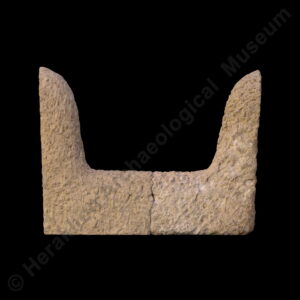
One of the most important symbols of the Minoan religion. The most widely accepted interpretation is that they represent bulls’ horns, depicting “the part for the whole” of the animal that played a highly symbolic role in the religion and ritual practices of Minoan Crete. Horns of consecration appear as a symbol in the iconography from as early the Protopalatial period. In the Neopalatial period, stone horns of consecration adorned religious buildings and signalled the sanctity of cult places (enclosures, open-air shrines, peak sanctuaries), as we know from the iconography (frescoes, seals, signet rings) and also from the actual objects excavated, some of them up to two metres high. Smaller examples, made of stone, clay and plaster, may also have been used in indoor spaces that functioned as shrines. Horns of consecration are often combined with other symbols such as the double axe, which is depicted socketed between the horns. In the Final Palatial and Postpalatial periods, horns of consecration, usually small, are found at open-air community shrines, in larnax iconography, on the diadems of “goddesses with upraised arms” and on “snake tubes”, tubular utensils which were probably stands for vessels with offerings to the gods.